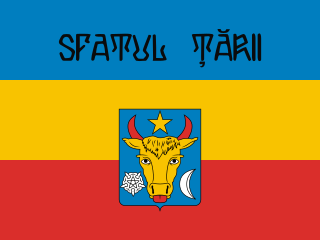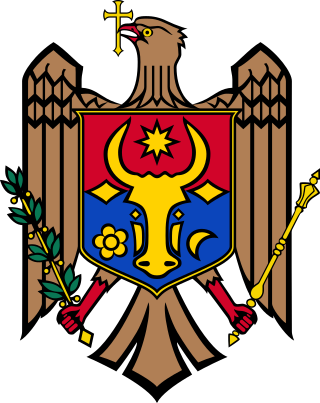Related Research Articles
The history of Moldova can be traced to the 1350s, when the Principality of Moldavia, the medieval precursor of modern Moldova and Romania, was founded. The principality was a vassal of the Ottoman Empire from 1538 until the 19th century. In 1812, following one of several Russian-Turkish wars, the eastern half of the principality, Bessarabia, was annexed by the Russian Empire. In 1918, Bessarabia briefly became independent as the Moldavian Democratic Republic and, following the decision of the Parliament, united with Romania. During the Second World War it was occupied by the Soviet Union which reclaimed it from Romania. It joined the Union as the Moldavian ASSR, until the dissolution of the USSR. In 1991 the country declared independence as the Republic of Moldova.

The Moldavian Soviet Socialist Republic or Moldavian SSR, also known as the Moldovan Soviet Socialist Republic, Moldovan SSR, or simply Moldavia or Moldova, was one of the 15 republics of the Soviet Union which existed from 1940 to 1991. The republic was formed on 2 August 1940 from parts of Bessarabia, a region annexed from Romania on 28 June of that year, and parts of the Moldavian Autonomous Soviet Socialist Republic, an autonomous Soviet republic within the Ukrainian SSR.

The Moldavian Democratic Republic, also known as the Moldavian Republic, was a state proclaimed on 15 December [O.S. 2 December] 1917 by the Sfatul Țării of Bessarabia, elected in October–November 1917 following the February Revolution and the start of the disintegration of the Russian Empire.

The Moldavian Autonomous Soviet Socialist Republic, shortened to Moldavian ASSR, was an autonomous republic of the Ukrainian SSR between 12 October 1924 and 2 August 1940, encompassing the modern territory of Transnistria as well as much of the present-day Podilsk Raion of Ukraine. It was an artificial political creation inspired by the Bolshevik nationalities policy in the context of the loss of larger Bessarabia to Romania in April 1918. In such a manner, the Bolshevik leadership tried to radicalize pro-Soviet feelings in Bessarabia with a goal to return it in the presence of favorable conditions and creation of geopolitical "place d'armes" (bridgehead) to execute a breakthrough in the Balkan direction by projecting influence upon Romanian Bessarabia, which was eventually occupied and annexed in 1940 after the signing of the Molotov–Ribbentrop Pact.

Ion Ionescu de la Brad, born Ion Isăcescu, was a Moldavian, later Romanian revolutionary, agronomist, statistician, scholar, and writer.

Sfatul Țării was a council that united political, public, cultural, and professional organizations in the greater part of the territory of the Governorate of Bessarabia in the disintegrating Russian Empire, which was transformed into a Legislative body and proclaimed the Moldavian Democratic Republic as part of the Russian Federative Republic in December 1917, and then union with Romania in April [O.S. March] 1918.
Moldova participated in the Eurovision Song Contest 2008 with the song "A Century of Love" written by Oleg Baraliuc and Victoria Demici. The song was performed by Geta Burlacu. The Moldovan broadcaster TeleRadio-Moldova (TRM) organised the national final O melodie pentru Europa 2008 in order to select the Moldovan entry for the 2008 contest in Belgrade, Serbia. 27 entries competed to represent Moldova in Belgrade, with 12 being shortlisted to participate in the televised national final which took place on 9 February 2008. "A Century of Love" performed by Geta Burlacu emerged as the winner after gaining the most points following the combination of votes from a jury panel, a TRM committee and a public televote.

Pantelimon Erhan Cabinet was the Cabinet of Moldova.

Indirect elections for the Moldovan Parliament took place in Moldova in November 1917. The members were elected by the various congresses, soviets, parties and professional and ethnic organizations existing in Bessarabia in the wake of the Russian Revolution.

Ion Ciubuc was an economist and a Moldovan politician who served as the 3rd Prime Minister of Moldova from January 1997 to February 1999.
The National Moldavian Party was a political party in Bessarabia.

Viaţa Basarabiei is a Romanian-language periodical from Chişinău, Moldova. Originally a literary and political magazine, published at a time when the Bessarabia region was part of Romania, it was founded in 1932 by political activist Pan Halippa and writer Nicolai Costenco. At the time, Viaţa Basarabiei was primarily noted for rejecting the centralism of Greater Romanian governments, to which they opposed more or less vocal Bessarabian regionalist demands and a nativist ethos.
Alexandru Robot was a Romanian, Moldovan and Soviet poet, also known as a novelist and journalist. First noted as a member of Romanian literary clubs, and committed to modernism and the avant-garde, he developed a poetic style based on borrowings from Symbolist and Expressionist literature. Also deemed a "Hermeticist" for the lexical obscurity in some of his poems, as well as for the similarity between his style and that of Ion Barbu, Robot was in particular noted for his pastorals, where he fused modernist elements into a traditionalist convention.

Vlad Ioviţă was a film director from Moldova also known as a writer and publicist.
Ion Dosca is a Moldavian Brazilian draughts player, international grandmaster since 1996 and world champion in 1999. Dosca also plays other variants of draughts, such as Russian checkers and pool checkers and won numerous national championships in both variants.
The 2013–14 Moldovan National Division is the 23rd season of top-tier football in Moldova. The competition began in July 2013 and ended in May 2014.
Andrei Burlacu is a Romanian professional footballer who plays as a forward for Liga II club CSM Reșița.

Timofei Moșneaga was a Moldovan physician and politician who served as the Minister of Health of Moldova from 1994 to 1997. He was the Director of the Republican Clinical Hospital for over forty years (1960–2003). As of 2017, the hospital is named after him.

Greater Moldova or Greater Moldavia is an irredentist concept today used for the credence that the Republic of Moldova should be expanded with lands that used to belong to the Principality of Moldavia or were once inside its political orbit. Historically, it also meant the unification of the lands of the former principality under either Romania or the Soviet Union. Territories cited in such proposals always include Western Moldavia and the whole of Bessarabia, as well as Bukovina and the Hertsa region; some versions also feature parts of Transylvania, while still others include areas of Podolia, or Pokuttia in its entirety. In its most post-Soviet iterations, "Greater Moldova" is associated with a belief that Moldovans are a distinct people from Romanians, and that they inhabit parts of Romania and Ukraine. It is a marginal position within the Moldovan identity disputes, corresponding to radical forms of an ideology polemically known as "Moldovenism".
